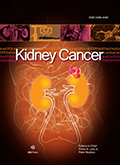Authors: Cignoli, Daniele | Fallara, Giuseppe | Re, Chiara | Cei, Francesco | Musso, Giacomo | Basile, Giuseppe | Rosiello, Giuseppe | Salonia, Andrea | Larcher, Alessandro | Montorsi, Francesco | Capitanio, Umberto
Article Type:
Systematic Review
Abstract:
BACKGROUND: The influence of age and comorbidities during decision-making for patients with renal cell carcinoma remains controversial. OBJECTIVE: To comprehensively review the available evidence regarding the impacts of age and comorbidities on the decision to perform partial nephrectomy (PN). EVIDENCE ACQUISITION: A systematic review was conducted in accordance with PRISMA and registered with PROSPERO (CRD42022344759). Only randomized control trials, prospective cohort studies, registry-based studies, or single/multi-institutional retrospective cohort studies comparing PN to other therapeutic options for cT1N0M0 renal masses were considered. The primary outcome was to assess differences in patients’ baseline characteristics between different treatments in
…order to investigate how those aspects have influenced clinical decision-making. Finally, perioperative outcomes were compared across the different options. EVIDENCE SYNTHESIS: Overall, patients who underwent PN were 3 to 11 years younger than those who underwent other treatments. Baseline renal function was slightly better in patients who underwent PN than in those who underwent radical nephrectomy (RN), active surveillance (AS), or tumor ablation. Patients undergoing PN had an average pre-treatment eGFR 4 to 6 points (mL/min/1.73 m2 ) higher than patients undergoing RN or tumor ablation. Likewise, the proportion of baseline chronic kidney disease (CKD) before treatment was higher in patients undergoing other treatments, with a rate of CKD between 6% and 56% higher compared with that for PN. A slightly higher proportion of baseline diabetes mellitus (DM) and cardiovascular comorbidities (CVD) were found in patients who underwent PN than in those who underwent RN (20% vs. 21% for DM and 37% vs. 41% for CVD). On average, patients who underwent AS and tumor ablation had more comorbidities, in terms of Charlson comorbidity index (CCI), DM, and CVD (50% vs. 38% for CCI ≥2; 25% vs. 20% for DM; and 43% vs. 37% for CVD). In terms of Eastern Cooperative Oncology Group (ECOG) Performance Status and American Society of Anesthesiologists (ASA) classification, no major differences were found between PN and other treatments, but a trend emerged whereby more fit patients underwent PN compared with RN (16% of ECOG >1 for PN vs. 18% for RN and 15% of ASA grade ≥3 for PN vs. 26% for RN). Again, tumor ablation was preferred for less fit patients (31% of ASA grade ≥3). No study included in our systematic review reported the baseline frailty status of patients treated for cT1 renal masses. The rates of perioperative complications and length of hospital stay (LOS) were similar between different techniques. CONCLUSIONS: Patients who underwent PN tended to be younger and fitter than those who underwent other available treatments for cT1 renal masses. Since this technique aims at reducing renal function impairment after surgery, a greater effort should be made to optimize patient selection to include more comorbid patients for whom PN might be useful.
Show more
Keywords: Partial nephrectomy, age, comorbidity, frailty, renal function, kidney cancer, kidney surgery
DOI: 10.3233/KCA-230001
Citation: Kidney Cancer,
vol. 7, no. 1, pp. 49-65, 2023





